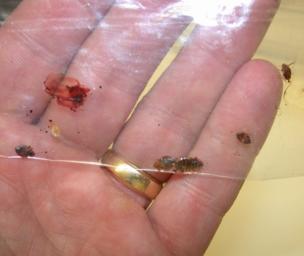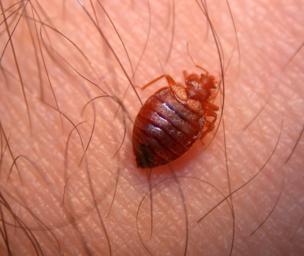What Do Bedbug Bites Look Like?

Warning

What Is a Bed Bug?

Where Are Bed Bugs Found?

How Big Are Bed Bugs?

Bed Bug Bites

What Is the Lifespan of a Bed Bug?

Do Bed Bug Bites Hurt?














What Are Bedbugs?
Bedbugs are smarter insects that can hide themselves nattily under beds and inside wooden cracks, and come out at night over the bed. The bugs move over your body and bite you, drinking your blood while you sleep. But bedbugs do not clean up the evidence, left behind in the form of blood spots.
Bedbugs are tiny, blood-sucking, parasitic insects that are reddish-brown in color. They hide in the cracks and crevices in beds, couches, box springs, headboards, bed frames, and any other objects near the bed. Bedbugs appear in homes, hotels, apartments, healthcare facilities, dormitories, shelters, schools, and on public transportation.
Apart from these places, bedbugs sometimes appear in movie theaters, laundromats, rental furniture, and office buildings. Immigration and international travel have contributed to the resurgence of bedbugs. These insects are about the size of an apple seed and feed on blood by biting exposed skin while people sleep. Adult bugs are about 3/16” long. They have flattened bodies that are oval in shape and reddish-brown in color.
They are often mistaken for carpet beetles, cockroaches, ticks, or other household insects. These insects do not fly or jump like fleas. However, they can crawl rapidly over floors, walls, and ceilings. Adult females lay eggs in secluded places, depositing one or two eggs per day. During their lifetime, they deposit potentially hundreds of eggs, which are about the size of a dust spec. They hatch after about a week at room temperature. They shed their skin five times before reaching maturity.
They crawl out of their hiding places at night as they are attracted by one’s body temperature and carbon dioxide. During the daytime, they prefer to hide close to where people sleep. Their flattened bodies enable them to fit into tiny crevices, especially box springs, mattresses, headboards, etc. These insects do not have any nests like ants or bees; they prefer to hide close to their feeding area. But, if required, they will crawl several feet for a meal.
Bedbug bites do not cause any skin reaction in most people, but, occasionally, people may develop an itchy, red bump, which appears fifteen to thirty minutes after getting bitten. This rash may last for several days. Although bedbugs cause a nuisance, they do not transmit any disease. However, appropriate actions should be taken immediately to prevent the spread of an infestation.
What Are the Symptoms of Bedbug Bites?
The following are symptoms of bedbug bites, which occur during the night:
- Swollen red marks or red blotch
- Itching with a burning sensation
- Multiple bites with straight lines
- Blisters or infected scratch marks
Most bites occur on the legs, neck, arms, and hands. The bites are prickly and sometimes allergic.
Common Symptoms of Bedbug Bites
The symptoms of a bedbug bite do not appear immediately; sometimes, it takes as long as a week for initial symptoms to appear. It usually happens to people who come back from vacation and find reddish marks all over their arms and legs.
The small, reddish bumps do not cause any pain in the beginning. Even the red marks are not clearly visible, and people do not feel any discomfort from them.
The different skin areas of the body behave and react differently; the hands, feet, and face, for example, are more sensitive and are affected more severely than other areas.
Chlorinated water makes the bites itchy due to the chemical reaction. The itchy bites can cause swelling and lead to large blisters. Scratching them should be avoided.
The bug bite symptoms will gradually fade away, but fresh, round bites will appear again.
Also, when a person is under stress, the bug marks become painful and will cause severe itching.
Different people will react differently to the bug bites. When two people sleep in the same bed, one may suffer from red marks all over the body while the other person may show no signs of bites.
What Are the Causes of Bedbug Bites?
Most people think bug bites on their body are not signs of bedbugs. Even the bites on the skin cannot easily indicate if it is a bedbug bite or a bite from another insect, or rashes due to a fungal infection. Such confusions sometimes prevent people from addressing the issue until it becomes a serious problem.
When a bug bites, it passes its saliva into the blood, which is anesthetic. According to a study, about 70% of people do not react to bedbug bites. While undergoing treatment for bedbug bites, it is necessary to treat not only the itching, but also the bedbug infestation.
Making a Diagnosis of Bedbug Bites
The following are clues that can help you identify the presence of bedbugs in and around your bed:
- Black dots of fecal stains formed due to smearing of digested and excreted blood
- Fecal stains of bedbugs differ from blood stains, though both appear on the bed and clothes.
- Bedbug shells may be found under the pillow or under the blanket, which indicates the bugs are getting bigger in size.
- The exoskeletons, or shells, of the bugs can be seen over the bed and furniture.
The evidence left behind is easier to locate than the bugs themselves, hiding under the bed and in the wall.
How to Treat Bedbug Bites
A bedbug check is a simple and effective technique to determine if your bed is occupied by bedbugs. If your bed is infested, you must act quickly.
Inspect the room, especially the area around your bed. Watch carefully for signs of bedbugs, fecal stains, and blood stains over the bed. Reduce the hiding area around the bed. Also, keep books, drawers, clothes, and electronic devices away. Do not keep pillows or cushions against the wall.
Heat is the best and most effective treatment. Set a heater to oscillate to spread the high temperatures around the room. Using a laser thermometer will help determine the right temperature; leave it at 130 degrees for two to four hours to kill the bedbugs.
Prevention of Bedbug Bites
Determine if there are bedbugs at your place; you need to find out if the bite marks are caused by bedbugs or something else. If you wake up at night due to any painful or itching sensation, scratching part of your body, and if you find any drops of blood over the sheet, it is possible you may have just crushed a bedbug which bit you.
Lifestyle and Coping
One has to be careful of bedbugs while at home or when going on vacation and staying in hotels. To get rid of the bugs, keep the area around the room and bed clean, and make use of effective pest control techniques, which are safe, easy, inexpensive, and can effectively kill the bugs in your room.
Bedbugs are a very common problem across the world. People staying at home or in hotels have to be careful about bedbugs, which are not easy to tackle and are severely infectious.
Risks and Complications
The risk of encountering a bedbug bite is greater for people spending their time in places with high turnovers of nighttime guests, for example:
- Hotels
- Hospitals or homeless shelters
- Trains and buses
- Cruise ships
- Refugee camps
Why Do Bedbugs Bite?
These insects feed on blood and depend on it for their food source. Hence, for survival, they must consume blood. One bug may take more than one bite, wherein it inserts its mouthparts into the blood vessel and starts feeding. However, finding a suitable blood vessel may take some time.
Since the bugs are sensitive to movement, they only act when the person is still or sleeping. If the person moves, the bug will withdraw and begin to search for its meal on another part of the body. A point to remember is that the number of bites a person receives is not indicative of the number of bedbugs feeding on that person.
Risk Factors
If the bite area is not kept clean or disinfected, or if the person starts scratching it, it may lead to secondary infection, such as further swelling or bleeding. People with weaker immune systems, elderly adults, and small children have higher chances of developing these secondary infections if not attended to properly.









